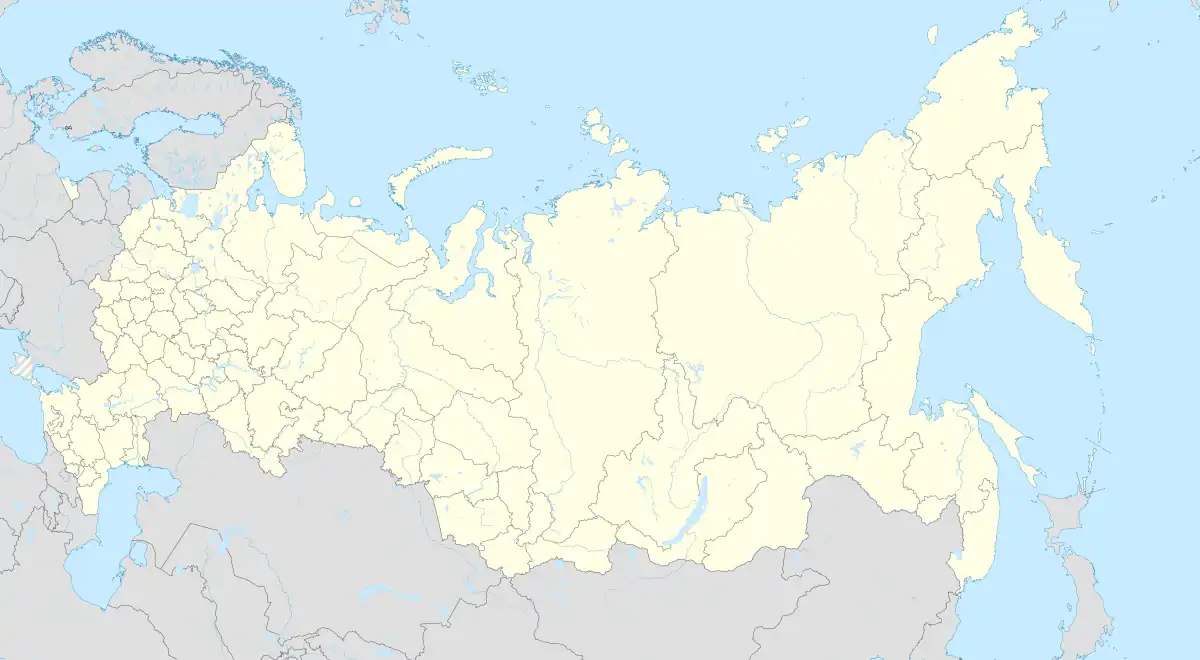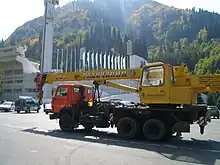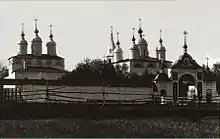Galich
Галич | |
|---|---|
 View of Galich | |
.png.webp) Flag .png.webp) Coat of arms | |
Location of Galich | |
 Galich Location of Galich  Galich Galich (Kostroma Oblast) | |
| Coordinates: 58°23′N 42°21′E / 58.383°N 42.350°E | |
| Country | Russia |
| Federal subject | Kostroma Oblast[1] |
| First mentioned | 1234 |
| Town status since | 1778 |
| Elevation | 130 m (430 ft) |
| Population | |
| • Total | 17,346 |
| • Estimate (2018)[3] | 16,911 (−2.5%) |
| • Subordinated to | town of oblast significance of Galich[1] |
| • Capital of | Galichsky District,[1] town of oblast significance of Galich[1] |
| • Urban okrug | Galich Urban Okrug[4] |
| • Capital of | Galich Urban Okrug,[4] Galichsky Municipal District[4] |
| Time zone | UTC+3 (MSK |
| Postal code(s)[6] | 157200–157203, 157209, 157229 |
| Dialing code(s) | +7 49437 |
| OKTMO ID | 34708000001 |
| Website | www |
| 2021 Census | 12,856[7] |
|---|---|
| 2010 Census | 17,346[2] |
| 2002 Census | 19,151[8] |
| 1989 Census | 21,652[9] |
| 1979 Census | 21,270[10] |
Galich (Russian: Га́лич) is a town in Kostroma Oblast, Russia, located on the southern bank of Lake Galichskoye. As of the 2021 Census, its population was 12,856.[7]
History
It was first chronicled in 1234 as Grad Mersky (lit. the town of the Merya). It gradually developed into one of the greatest salt-mining centers of Eastern Europe, eclipsing the southern town of Halych, from which it takes its name. In the 13th century, Galich was ruled by a younger brother of Alexander Nevsky and remained in his line until 1363, when the Muscovites seized the principality and ousted the ruling family to Novgorod.
The 15th and 16th centuries are justly considered the golden age of Galich. At that time it controlled most of the Russian trade in salt and furs. Dmitry Shemyaka and other local princes pressed their claims to the Muscovite crown, and three of them actually took possession of the Kremlin in the course of the Great Feudal War.
The early medieval earthen ramparts were further fortified in the early 15th and 16th centuries and have since been known as Shemyaka Hills. The Poles burnt it to the ground in 1612, Peter the Great had a wooden kremlin demolished, and it further declined with the transfer of Russian foreign trade from Arkhangelsk to St. Petersburg.
Town status was granted to Galich in 1778.
Administrative and municipal status
Within the framework of administrative divisions, Galich serves as the administrative center of Galichsky District,[1] even though it is not a part of it.[11] As an administrative division, it is incorporated separately as the town of oblast significance of Galich—an administrative unit with the status equal to that of the districts.[1] As a municipal division, the town of oblast significance of Galich is incorporated as Galich Urban Okrug.[4]
Economy

The Galich Mobile Crane Plant (Russian: ОАО "Галичский автокрановый завод") manufactures some 20% of Russia's entire mobile crane production.
Town's industries also manufacture steel barrels, shoes, and clothing. There is a timber mill in town as well.
The town is also a minor railroad node of the Trans-Siberian Railway.
A 350-meter (1,150 ft) tall guyed mast for FM and TV broadcasting can be seen in the town.
Culture

Historic monuments of Galich include various buildings from the imperial period of Russian history. Particularly noteworthy is the Paisiev Monastery, founded in the early 14th century and featuring a 16th-century five-domed cathedral and a three-domed church from 1642.
Since 2004, Galich hosts the annual short film festival "Russia's Family" (Russian: Семья России, Semya Rossii), whose stated goals are "to aid spiritual and moral healing of Russian society and to promote traditional family values".
References
Notes
- 1 2 3 4 5 6 7 Law #112-4-ZKO
- 1 2 Russian Federal State Statistics Service (2011). Всероссийская перепись населения 2010 года. Том 1 [2010 All-Russian Population Census, vol. 1]. Всероссийская перепись населения 2010 года [2010 All-Russia Population Census] (in Russian). Federal State Statistics Service.
- ↑ "26. Численность постоянного населения Российской Федерации по муниципальным образованиям на 1 января 2018 года". Federal State Statistics Service. Retrieved January 23, 2019.
- 1 2 3 4 Law #237-ZKO
- ↑ "Об исчислении времени". Официальный интернет-портал правовой информации (in Russian). June 3, 2011. Retrieved January 19, 2019.
- ↑ Почта России. Информационно-вычислительный центр ОАСУ РПО. (Russian Post). Поиск объектов почтовой связи (Postal Objects Search) (in Russian)
- 1 2 Russian Federal State Statistics Service. Всероссийская перепись населения 2020 года. Том 1 [2020 All-Russian Population Census, vol. 1] (XLS) (in Russian). Federal State Statistics Service.
- ↑ Russian Federal State Statistics Service (May 21, 2004). Численность населения России, субъектов Российской Федерации в составе федеральных округов, районов, городских поселений, сельских населённых пунктов – районных центров и сельских населённых пунктов с населением 3 тысячи и более человек [Population of Russia, Its Federal Districts, Federal Subjects, Districts, Urban Localities, Rural Localities—Administrative Centers, and Rural Localities with Population of Over 3,000] (XLS). Всероссийская перепись населения 2002 года [All-Russia Population Census of 2002] (in Russian).
- ↑ Всесоюзная перепись населения 1989 г. Численность наличного населения союзных и автономных республик, автономных областей и округов, краёв, областей, районов, городских поселений и сёл-райцентров [All Union Population Census of 1989: Present Population of Union and Autonomous Republics, Autonomous Oblasts and Okrugs, Krais, Oblasts, Districts, Urban Settlements, and Villages Serving as District Administrative Centers]. Всесоюзная перепись населения 1989 года [All-Union Population Census of 1989] (in Russian). Институт демографии Национального исследовательского университета: Высшая школа экономики [Institute of Demography at the National Research University: Higher School of Economics]. 1989 – via Demoscope Weekly.
- ↑ Всесоюзная перепись населения 1979 г. Национальный состав населения по регионам России [All Union Population Census of 1979. Ethnic composition of the population by regions of Russia] (XLS). Всесоюзная перепись населения 1979 года [All-Union Population Census of 1979] (in Russian). 1979 – via Demoscope Weekly (website of the Institute of Demographics of the State University—Higher School of Economics.
- ↑ Resolution #133-a
Sources
- Костромская областная Дума. Закон №112-4-ЗКО от 9 февраля 2007 г. «Об административно-территориальном устройстве Костромской области», в ред. Закона №567-5-ЗКО от 24 сентября 2014 г. «О внесении изменений в Закон Костромской области "Об административно-территориальном устройстве Костромской области"». Вступил в силу со дня официального опубликования. Опубликован: "СП — нормативные документы", №10(70), 28 февраля 2007 г. (Kostroma Oblast Duma. Law #112-4-ZKO of February 9, 2007 On the Administrative-Territorial Structure of Kostroma Oblast, as amended by the Law #567-5-ZKO of September 24, 2014 On Amending the Law of Kostroma Oblast "On the Administrative-Territorial Structure of Kostroma Oblast". Effective as of the official publication date.).
- Администрация Костромской области. Постановление №133-а от 8 апреля 2014 г. «Об утверждении реестра населённых пунктов Костромской области». Вступил в силу 11 апреля 2014 г. Опубликован: "СП — нормативные документы", №15, 11 апреля 2014 г. (Administration of Kostroma Oblast. Resolution #133-a of April 8, 2014 On the Adoption of the Registry of the Inhabited Localities of Kostroma Oblast. Effective as of April 11, 2014.).
- Костромская областная Дума. Закон №237-ЗКО от 30 декабря 2004 г. «Об установлении границ муниципальных образований в Костромской области и наделении их статусом», в ред. Закона №496-5-ЗКО от 28 февраля 2014 г. «О внесении изменений в Закон Костромской области "Об установлении границ муниципальных образований в Костромской области и наделении их статусом"». Вступил в силу по истечении 10 дней со дня официального опубликования. Опубликован: "Северная Правда" ("Документы: СпецВыпуск"), №8, 26 января 2005 г. (Kostroma Oblast Duma. Law #237-ZKO of December 30, 2004 On the Establishment of the Borders of the Municipal Formations and on Granting Them Statuses, as amended by the Law #496-5-ZKO of February 28, 2014 On Amending the Law of Kostroma Oblast "On the Establishment of the Borders of the Municipal Formations and on Granting Them Statuses". Effective as of after 10 days following the official publication date.).
External links
 Media related to Galich at Wikimedia Commons
Media related to Galich at Wikimedia Commons- Official website of Galich (in Russian)
- Unofficial website of Galich (in Russian)
- Another unofficial website of Galich (in Russian)
- Galich directory of organizations (in Russian)